
The Coronation of the Virgin is a 1414 tempera on panel polyptych by the Italian late Gothic artist Lorenzo Monaco, centred on the subject of the Coronation of the Virgin. Once in the Camaldolese monastery of Santa Maria degli Angeli, it is now housed in the Uffizi Gallery in Florence. It is dated February 1413 which, in the Florentine calendar, corresponded to 1414.
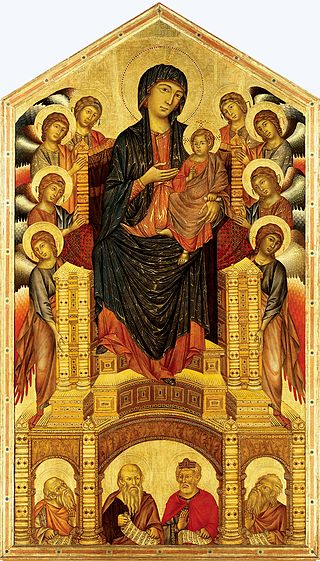
The Santa Trinita Maestà is a panel painting by the Italian medieval artist Cimabue, dating to c. 1290-1300. Originally painted for the church of Santa Trinita, Florence, where it remained until 1471, it is now housed in the Uffizi Gallery of Florence, Italy. It represents the Madonna enthroned with the Baby Jesus and surrounded by eight angels and, below, four half portraits of prophets.

The Lamentation of Christ is an oil-on-panel painting of the common subject of the Lamentation of Christ by the Netherlandish artist Rogier van der Weyden, dating from around 1460–1463 and now in the Uffizi Gallery, Florence, Italy.
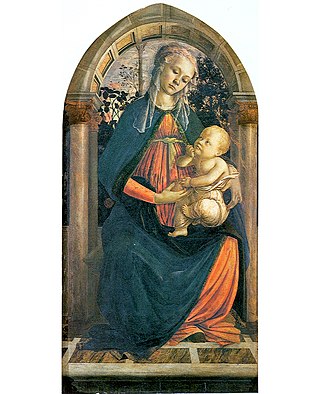
The Madonna of the Rose Garden is a tempera on panel painting made by Sandro Botticelli, whose date of between 1469 and 1470 makes it one of his earliest paintings. It is now in the Uffizi Gallery in Florence, Italy.

The Madonna of the Caves is a tempera on panel painting measuring 32 cm 29.6 cm. It was painted in 1488-1490 by the Italian painter Andrea Mantegna and is now in the Uffizi Gallery in Florence.
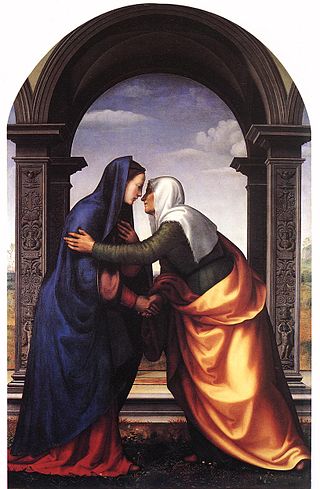
Visitation is a 1503 painting of the Visitation of the Virgin Mary to Elizabeth by Mariotto Albertinelli. The date is shown on both columns in the work. It is now in the Uffizi in Florence.

The Novitiate Altarpiece or Madonna and Child with Saints is a c.1440-1445 tempera on panel painting by Filippo Lippi, now in the Uffizi in Florence. A sacra conversazione, it originally had a predella painted by Pesellino centred on a Nativity. The main panel shows Cosmas and Damian either side of the Madonna and Child, whilst Francis of Assisi is shown at far left and Anthony of Padua at far right. On an architectural frieze above the figures are the Medici's heraldic balls.

St Dominic is a c. 1475 tempera and gold on panel painting, now in the Uffizi Gallery in Florence.

Christ the Redeemer with Four Saints is a 1271 tempera and gold on panel painting, signed and dated by Meliore di Jacopo. From the left to right the saints are Peter, the Virgin Mary, John the Evangelist and Paul of Tarsus. It is now in the Uffizi Gallery in Florence.

The Panciatichi Holy Family or Panciatichi Madonna and Child is a 1541 oil on panel painting by Bronzino, signed on a stone in the bottom left corner. It is now in the Uffizi in Florence, where it was first recorded in the Tribuna in 1704, where it remained until 2010, when it was moved as part of the "New Uffizi" project. Preparatory drawings for the work are in the Uffizi's Gabinetto dei Disegni e delle Stampe and in the Phillips collection in London.

The Martyrdom of Saint Justina is a c.1570–1575 oil-on-canvas painting by the Italian painter Paolo Veronese with assistance from his younger brother, originally produced for Santa Giustina Basilica in Padua and now in the Uffizi in Florence. It shows the martyrdom of Justina of Padua.

Portrait of Iseppo da Porto and his son Adriano is a c.1555 oil-on-canvas painting by Paolo Veronese, now in the Contini Bonacossi collection, on long-term loan to the Uffizi in Florence. Veronese also decorated Porto's Palazzo Porto in Vicenza, designed by Andrea Palladio and completed in 1552.
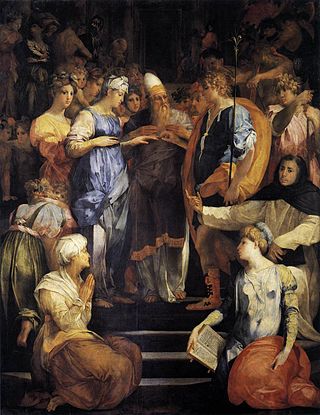
Marriage of the Virgin or the Ginori Altarpiece is a 1523 oil on panel painting by Rosso Fiorentino, signed and dated by the artist. It was commissioned by Carlo Ginori for the chapel dedicated to the Virgin Mary and Saint Joseph - previously owned by the Masi family that chapel had been acquired by the Ginori family in 1520. It still hangs in the Basilica, whilst a drawn copy attributed to Antonio Circignani is now in the Louvre (n.1592).

Cherub Playing a Lute or Musical Cherub is a 1521 oil on panel painting by Rosso Fiorentino, now in the Uffizi in Florence. It is signed "Rubeus Florentinus" and dated - though the date is unclear it probably reads 1521.

Portrait of a Young Woman is a c. 1510 oil on canvas painting, usually attributed to Rosso Fiorentino, though Giovanni Larciani has also recently been suggested as its artist. It is now in the Uffizi in Florence. It is usually thought to be an early work by Rosso, produced before the frescos of the Chiostrino dei Voti at Santissima Annunziata, Florence, though its sharp style makes it hard to give a definite attribution to Rosso.

Supper at Emmaus is a 1525 oil on canvas painting by Pontormo and now in the Uffizi in Florence. It is one of the smallest works signed and dated by the artist, in this case on the abandoned scroll in the foreground.

Woman with a Basket of Spindles is an oil-on-panel painting, executed c. 1514–1515, now in the Uffizi in Florence. It is attributed to Pontormo or Andrea del Sarto. The work arrived in the Palazzo Pitti's gallery in 1773, as recorded in a note on the reverse, and in 1784 it was hanging in the Sala dell'Ermafrodito. It was last restored in 1996.

Portrait of Cosimo the Elder is an oil on panel painting by Pontormo, executed c. 1519–1520, now in the Uffizi, Florence.
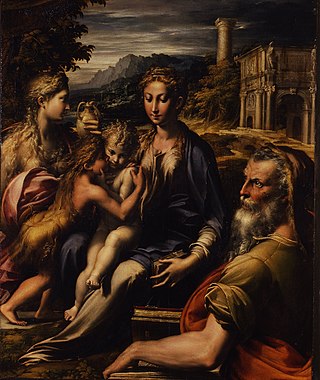
Madonna and Child with Saint Zechariah is a c.1530–1533 oil on panel painting by Parmigianino, now in the Uffizi. It shows the Madonna and Child with Zechariah, father of John the Baptist.

Madonna and Child is a 1450 tempera on panel painting by Jacopo Bellini, now in the Uffizi in Florence. It was bought for its present home by Corrado Ricci in 1906 from a monastery in Lucca in 1906, where it had been spotted by the antiquarian Costantini, with the sale provoking several polemics in the newspapers.




















